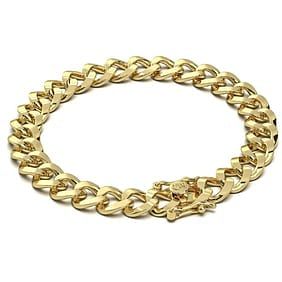Heavy 8th C. Viking Silver Bracelet w/ Serpent Motif
Lot 113
About Seller
Artemis Fine Arts
686 S Taylor Ave, Ste 106
Louisville, CO 80027
United States
Selling antiquities, ancient and ethnographic art online since 1993, Artemis Gallery specializes in Classical Antiquities (Egyptian, Greek, Roman, Near Eastern), Asian, Pre-Columbian, African / Tribal / Oceanographic art. Our extensive inventory includes pottery, stone, metal, wood, glass and textil...Read more
Categories
Estimate:
$5,000 - $7,500
Absentee vs Live bid
Two ways to bid:
- Leave a max absentee bid and the platform will bid on your behalf up to your maximum bid during the live auction.
- Bid live during the auction and your bids will be submitted real-time to the auctioneer.
Bid Increments
| Price | Bid Increment |
|---|---|
| $0 | $25 |
| $300 | $50 |
| $1,000 | $100 |
| $2,000 | $250 |
| $5,000 | $500 |
| $10,000 | $1,000 |
| $20,000 | $2,500 |
| $50,000 | $5,000 |
| $100,000 | $10,000 |
| $200,000 | $20,000 |
About Auction
By Artemis Fine Arts
Jun 10, 2021
Set Reminder
2021-06-10 10:00:00
2021-06-10 10:00:00
America/New_York
Bidsquare
Bidsquare : Exceptional Antiquities | Asian | Ethnographic
https://www.bidsquare.com/auctions/artemis-gallery/exceptional-antiquities-asian-ethnographic-7012
Museum-worthy examples of Egyptian, Greek, Roman, Viking, Near Eastern, Far East / Asian, Pre-Columbian, African / Tribal, Oceanic, Native American, Spanish Colonial, Russian, Fossils, Ancient Jewelry, Fine Art, so much more! Artemis Fine Arts info@artemisgallery.com
Museum-worthy examples of Egyptian, Greek, Roman, Viking, Near Eastern, Far East / Asian, Pre-Columbian, African / Tribal, Oceanic, Native American, Spanish Colonial, Russian, Fossils, Ancient Jewelry, Fine Art, so much more! Artemis Fine Arts info@artemisgallery.com
- Lot Description
Northern Europe, Scandinavia, Viking or Norse culture, ca. 8th to 10th century CE. An amazing and wearable bracelet of a hefty form shaped from a dense slab of 93% silver. The penannular composition is quite attractive and features petite stamped triangles on the terminals with registers of incised striations just above, a trio of deep, W-shaped serpentine grooves on each arm, and a stippled ground in the middle. Atop the spotted central surface is a sinuous, snake-like creature known as Jormungandr, the World Serpent with a segmented body slithering around itself as it consumed the end of its own tail. The underside of the bracelet is slightly concave to enhance the comfortability of the wearer. Size (bracelet): 3.3" W x 3.125" H (8.4 cm x 7.9 cm); (band): 1.3" W (3.3 cm); (wrist opening): 1" W (2.5 cm); quality of silver: 93%; total weight: 172.2 grams
The serpent form may relate to the Norse myth of Jormungandr (Jormungand), the Midgard Serpent, a child of Loki and a giantess who according to legend grew so large that it was able to surround the earth and grasp its own tail, forming an ouroboros. According to legend, when Jormungandr releases its tail, the final battle of the gods that will result in Earth becoming completely covered in water - known as Ragnarok - will begin. One of the most popular motifs in Norse art concerns the story of Thor and Jormungandr. In classic Thor style, he sets off on a reckless fishing expedition, taking the head of an ox as his bait, and sails further out to sea than he should. With a large hook and the ox head, he catches Jormungandr, who surfaces with poison and blood dripping from his mouth. Thor's fishing companion, the giant Hymir, quickly cuts Thor's line before he can slay the serpent with his hammer and Jormungandr sinks beneath the waves, the threat at bay - for the moment. Multiple Viking picture stones have been found depicting this story, including one from as early as the late 8th century.
This piece has been searched against the Art Loss Register database and has been cleared. The Art Loss Register maintains the world’s largest database of stolen art, collectibles, and antiques.
Provenance: private New York, New York, USA collection; ex-private Kaliningrad (Koenigsberg) and then Latvia collection; found on the Baltic Sea coast prior to 1982
All items legal to buy/sell under U.S. Statute covering cultural patrimony Code 2600, CHAPTER 14, and are guaranteed to be as described or your money back.
A Certificate of Authenticity will accompany all winning bids.
We ship worldwide and handle all shipping in-house for your convenience.
#164130Wearable as shown. Bracelet is professionally cleaned on all surfaces with some abrasions visible. Two very small perforations along one band. Light encrustations within some recessed areas, with minor softening to finer details, and very slight bending to terminals. Wonderful patina throughout, and nice preservation to central serpentine decoration.Condition
- Shipping Info
-
All shipping is handled in-house for your convenience. Your invoice from Artemis Gallery will include shipping calculation instructions. If in doubt, please inquire BEFORE bidding for estimated shipping costs for individual items.
-
- Buyer's Premium



 EUR
EUR CAD
CAD AUD
AUD GBP
GBP MXN
MXN HKD
HKD CNY
CNY MYR
MYR SEK
SEK SGD
SGD CHF
CHF THB
THB














